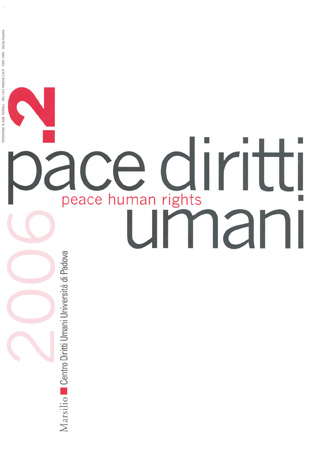Raccolte

Quod barbari non fecerunt, fecerunt Barberini. L’assalto all’edificio dei diritti umani
- Contenuto in
- Pace diritti umani - Peace Human Rights, 2/2006
- Tipologia pubblicazione
- Articolo / Saggio
- Pagine
- 7-19
- Lingua
- IT
Quod barbari non fecerunt, fecerunt Barberini. Assaulting the Building of Human Rights
Antonio Papisca
It is well known that in the Renaissance Rome the most powerful families destroyed ancient monuments, partially also the Colosseum, to get building material for their sumptuous palaces. The metaphor could be used to describe what is going on today by claiming «less freedom, more security». There are powerful and super-powerful political leaderships that are trying to demolish what was being built since the coming of the United Nations Charter and the Universal Declaration of Human Rights. World is endowed with a paramount fertile construction in progress. We got the international legal recognition of human rights as well as an imposing international machinery for their promotion and protection, that is surrounded by a worldwide network of civil society organisations and transnational social movements. In despite of this flourishing reality, terrorism is worldwide spreading but the response is not to facilitate and strengthen the human rights machinery and the rule of law from the city up to the international institutions. There are governments that claim the right to make war, even preventive war, the old ius ad bellum that the United Nations Charter has proscribed once for all.
Torture prohibition is a strong principle that belongs to the upper sphere of ius cogens. But torture is being boldly practised even in states the historical identity of which is that of the rule of law defenders. The story of the replacement of the «old» Human Rights Commission with the «new» Human Rights Council is revealing of a trend aiming at perverting the nature of the United Nations whose original ratio is ad omnes includendos (to include all), not to discriminate in accordance with the law of the strongest. The author wonders whether there is something truly new with the «new» Council. He argues that nothing but the «label» is new. The Council’s membership is still intergovernmental, and no progress at all for the NGOs status. The really new is the «peer review» practice, the new Council’s function that would complement the old Commission’s functions but that could overlap the fertile practice of reporting at the Treaty Bodies. The result will be lowering the degree of impartial and supranational authority exercised by the present seven Human Rights Committees. A further reason of concern lies in the fact that being«subsidiary» of the General Assembly, the new Council has no direct formal relationship with the Economic and Social Council: the risk is that civil and political rights would possibly prevail on economic and social rights disregarding the principle of interdependence and indivisibility of all human rights. Before the new situation, the author thinks that the political agenda, dealing with the United Nations reform, should consider as a priority to balance the overall human rights machinery by reinforcing its «independent» side, that is the Treaty Bodies system. The suggestion of a «Unified Standing Treaty Body» formally submitted by the United Nations High Commissioner for Human Rights should be urgently taken into highest consideration.

